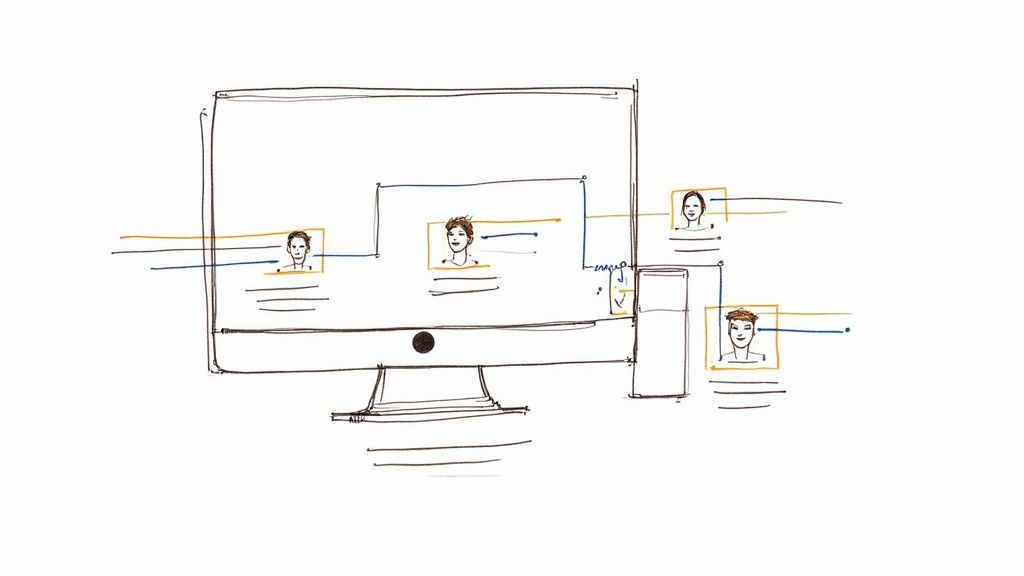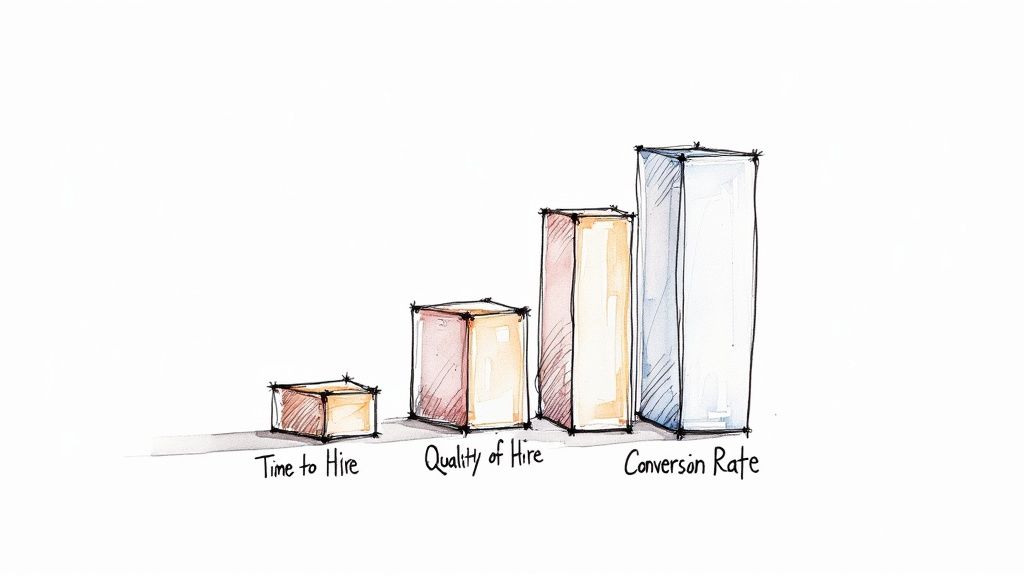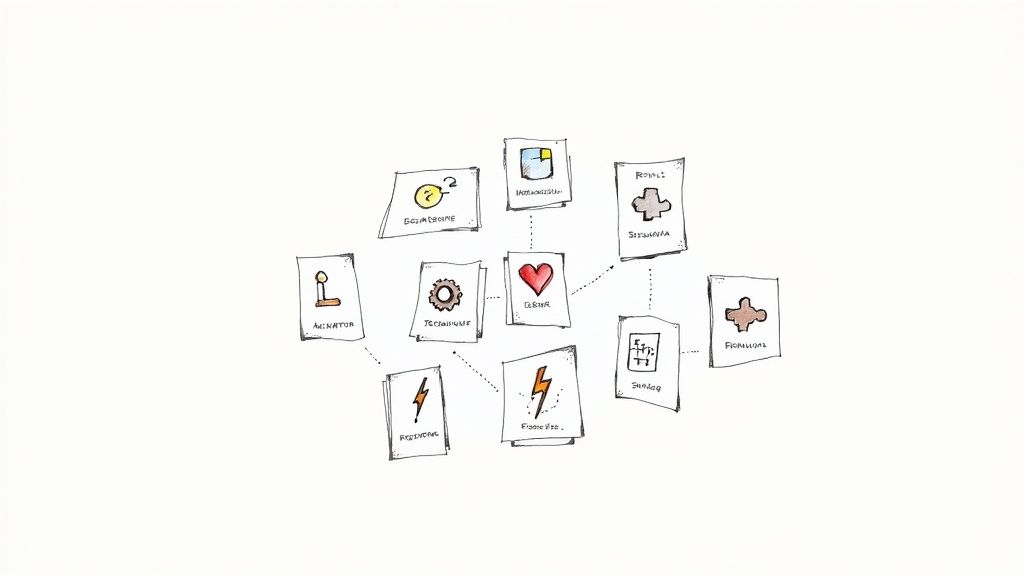Let's be honest: talent pipeline management is just a fancy term for ditching the chaotic, expensive cycle of 'just-in-time' hiring. It’s the difference between hoping for rain and building your own damn irrigation network. One works. The other leaves you high and dry.
Why Your Hiring Process Feels Broken (Because It Is)
If your recruiting strategy feels like a frantic loop of posting jobs, praying for good applicants, and panicking when you have to start all over again three months later, you’re not alone. I’ve been there. That reactive cycle isn't just exhausting; it's a fundamentally flawed business model. You’re constantly on the defensive, paying premium recruiting fees and often settling for whoever is available right now.
This isn't a sustainable way to build a company. Hope you enjoy spending your afternoons fact-checking resumes and squeezing in last-minute interviews—because that’s now your full-time job.
The $50,000 "Hello" and Other Costs of Reactive Hiring
The "post and pray" method misses a fundamental truth: the best people usually aren't looking for a job. They’re busy making an impact in their current roles. By only fishing when you're hungry, you're missing out on a massive pool of talent that isn’t actively scrolling through job boards.
This creates a few painful realities for your business:
- You Overpay: Desperation is expensive. You end up shelling out for hefty agency fees or inflated salaries just to land someone quickly. I call it the "$50,000 Hello."
- You Settle: The best candidate on the market isn’t necessarily the best candidate for the role. You’re forced to compromise on skills or culture fit simply to fill the seat. It's a compromise you'll pay for later.
- You Burn Out: Your team gets stuck in a constant scramble of interviewing and onboarding, pulling focus from their actual work. It’s a perfect recipe for burnout and mediocre results.
Think of it this way: a broken hiring process is like a leaky bucket. You can keep pouring more water (money and effort) into it, but you'll never be full until you fix the holes. Talent pipeline management is about fixing the bucket.
Shifting from Chaos to Cultivation
This is where talent pipeline management becomes a mindset shift. It’s about building relationships before you need them. It’s about knowing who your next great hire might be six months before the job even exists. This proactive approach turns hiring from a panicked reaction into a predictable, strategic advantage.
The world of work is changing faster than ever. The World Economic Forum’s Future of Jobs Report projects that roughly 22% of the global workforce will see their jobs transform, with millions of new roles emerging as old ones disappear. Relying on last-minute hiring in that environment is a surefire way to get left behind. I'd recommend exploring the full report to really grasp these labor market shifts and why proactive talent strategies are so critical.
This isn't about being perfect. We're not saying we're perfect. Just more accurate more often. It’s about being prepared. It’s about building a system that delivers a consistent, sustainable flow of top-tier talent—one that fuels your growth instead of draining your resources.
Let’s get practical. Building a talent pipeline isn't some mystical art form. It's a system—a predictable, repeatable process that turns complete strangers into your next star employees. If you've ever tried to build one and failed, chances are you missed a stage or tried to jump ahead.
Forget the abstract theories for a moment. We're going to walk through the four core stages that separate a well-oiled talent machine from a messy, expensive hobby. This is the blueprint for turning hiring chaos into a strategic advantage.
Stage 1: Sourcing And Attraction (AKA Not Just Posting on LinkedIn)
This is where it all begins, and frankly, it's where most companies get it wrong. Sourcing and attraction isn't about blasting a job description across every job board you can find and hoping for the best. That's reactive. True sourcing is about proactively identifying and flagging the right people, even when they aren't actively looking.
Think of it as building a "watch list" of talent. You’re spotting high-performers at competing companies, engaging with insightful people on LinkedIn, and taking note of impressive speakers at industry events. You’re building your database of potential hires long before a hiring manager ever approves a job req. This is where you plant the seeds for future success.

The key takeaway here is that great sourcing isn’t a one-off action. It's a connected system of relationship building, brand marketing, and strategic networking that works for you 24/7.
Stage 2: Engagement And Nurturing (The Art of Not Being a Pest)
Okay, so you've got a list of interesting people. Now what? The absolute worst thing you can do is go silent until you need something from them. That’s like making a great first impression at a party and then ghosting your new acquaintance for six months. All that initial effort? Wasted.
Engagement and nurturing is all about playing the long game. It’s the subtle, consistent art of staying on their radar without becoming annoying. This stage involves:
- Sharing value, not just jobs: Don't just spam them with open roles. Send them a fascinating industry report, an insightful article you wrote, or a link to a webinar you genuinely think they'd enjoy.
- Using personal touchpoints: A quick "congrats" on a work anniversary or a thoughtful comment on a project they shared on LinkedIn goes a surprisingly long way.
- Making low-stakes invitations: Think about virtual Q&A sessions with your department lead or an invite to a company-sponsored meetup. No pressure, just connection.
The goal isn't constant contact; it's relevant contact. You're trying to build a genuine professional relationship. When they eventually decide it’s time for a change, you want your company to be the first one they think of.
Stage 3: Qualification And Vetting (The Slow Burn)
As you nurture these relationships, you'll naturally begin to see who the real contenders are. Qualification and vetting in a pipeline model happens long before any formal interview process. It’s a gradual confirmation that someone has the core skills, cultural alignment, and genuine interest to be a great future fit.
This could look like a casual 15-minute "get to know you" call with a team lead or inviting them to a fun technical challenge (if that fits your company culture). You’re gathering data points over time, not cramming them into a high-pressure, one-day interview sprint.
This slow-burn vetting gives you a much deeper, more authentic read on a candidate. It also helps weed out the tire-kickers from those who are truly invested in what you're building.
The Old Way vs The Pipeline Way of Hiring
To really drive home the difference, let's look at the mindset shift. Moving from reactive recruiting to proactive pipelining changes almost every aspect of how you hire.
| Hiring Aspect | The Old Reactive Way | The Proactive Pipeline Way |
|---|---|---|
| Timing | Starts when a job opens. It's a scramble. | Always on. It's a continuous process. |
| Candidates | Sourced from active job seekers (a small pool). | Sourced from active & passive talent (a huge pool). |
| Relationship | Transactional. "Apply now." | Relational. "Let's stay in touch." |
| Speed | Slow. Average time-to-hire is weeks or months. | Fast. Key roles filled in days. |
| Quality | A gamble based on who's available right now. | A strategic choice from a pre-vetted pool. |
The table above isn't just a comparison; it’s a road map from chaos to control. The pipeline approach puts you in the driver's seat of your company's growth.
Stage 4: Ready-To-Hire Pooling (Your Secret Weapon)
This is the payoff. Your ready-to-hire pool is your company's secret weapon. These aren't just names on a list; they are candidates who have been sourced, nurtured, and pre-vetted. You know their skills, you understand their career goals, and you've already built a strong rapport.
When a role finally opens up, you don't have to post and pray. You shop from your own exclusive, curated talent pool. Your time-to-hire plummets. While the average time-to-hire is a painful 41 days, a well-managed pipeline can destroy that metric, filling roles in a fraction of the time.
You’re not just hiring faster; you're hiring better because you've had months, not hours, to make an informed decision. The value of this approach doesn't stop at the offer letter, either. The success of a talent pipeline hinges on how these carefully chosen hires are integrated. Exploring effective onboarding best practices to improve employee success is the final step that turns a great hire into a long-term, high-performing asset.
Stop Posting and Praying, Start Thinking Like a Media Company
If your only recruiting strategy is to post a job description and wait for the magic to happen, you're essentially fishing with an empty hook. I've seen it a hundred times: companies toss a generic job ad into the void and then act shocked when they only catch bottom-feeders.
Let’s get one thing straight. The best people aren't desperately scrolling through job boards. They are heads-down, crushing it in their current roles and making their bosses look good. To get on their radar, you have to stop acting like a frantic recruiter and start thinking like a media company.
Build a Brand That Breathes
Your employer brand isn't the mission statement you paid a consultant a fortune to write. It’s the sum of every interaction someone has with your company. It’s what your employees say about you after their second beer on a Friday night. You need to build a talent brand that’s an authentic reflection of your culture, not some polished marketing fantasy.
So how do you pull that off? You stop hiding behind corporate jargon.
- Showcase the Real Work: Create content that highlights the actual challenges and triumphs your team faces. Write a blog post about a gnarly problem your engineers just solved. Share a detailed case study on a client win your sales team absolutely nailed. This is infinitely more interesting than another photo of the office ping-pong table.
- Let Your Team Be the Stars: Your current employees are your most powerful talent magnets. Get them involved. Encourage them to share their work on LinkedIn, speak at industry events, or contribute to your company blog. Turns out you don’t need to bribe them with free pizza; you just need to give them a platform and a voice.
- Run Hyper-Targeted Micro-Campaigns: Instead of blasting a single, massive job ad out to the masses, think smaller and smarter. Identify 20-30 ideal candidates for a future role on LinkedIn. Then, create a small, targeted ad campaign that speaks directly to their pain points and career ambitions. It’s less about reach and all about resonance.
The goal isn’t to be flashy; it’s to be real. Authenticity attracts the right kind of people and repels the wrong ones, which is just as important for effective talent pipeline management.
Turn Your Team into Talent Scouts, Not Hoarders
Your people already know what it takes to succeed at your company. They also have networks full of other smart, capable people. An employee referral program is a decent start, but you can go so much deeper.
It's time to train your managers to be talent scouts, not just talent hoarders.
When they’re at an industry conference, they should be identifying impressive speakers. When they see incredible work coming from a competitor, they should be making a note of who did it. This simple shift in mindset transforms your entire leadership team into a proactive sourcing engine.
This is also where engagement makes a massive difference. According to one study, firms with engaged workforces see huge benefits, including turnover reductions between 21% and 51%. When your team is bought-in, they naturally become ambassadors for your brand. You can explore more data on how employee engagement impacts business outcomes to see the full picture.
An engaged team doesn't just stick around; they help you build the next generation of talent. To do this well, you also need modern tools that support this proactive approach. For instance, consider how you can modernize your recruitment process with on-demand asynchronous interviews to make connecting with this newfound talent both efficient and meaningful.
Ultimately, attracting top talent is about building a gravitational pull. It’s about creating a company culture and a public presence so compelling that the best people want to know what you’re up to, long before they’re even thinking about making a move. So stop posting and praying. Start building something worth joining.
Nurture Candidates Without Being A Stalker

So you’ve attracted some fantastic people. They’re on your radar, maybe you’ve even had a great chat. Now what? The single biggest mistake I see founders make is going completely radio silent until a job finally opens up six months down the line. All that rapport you built? Gone. Poof.
This is the nurturing stage, and it’s where most talent pipelines spring a serious leak. Nurturing is the delicate art of staying relevant without being annoying. It’s all about playing the long game. You aren't trying to land a candidate tomorrow; you're building a genuine relationship so that when the time is right, you're the first—and hopefully only—company they think of.
The Low-Friction Touchpoint
Your goal here isn't to demand their time; it's to earn their attention. Forget about sending those generic "Just checking in!" emails every month. That’s a one-way ticket to the spam folder. Instead, focus on creating low-friction touchpoints that offer real value.
I’m talking about simple, effective ways to stay connected that don’t feel like a sales pitch. Think of it more like professional networking, not a high-pressure recruitment blitz.
- Virtual Fireside Chats: Once a quarter, get your head of engineering or product on a 30-minute Zoom call. And don't brand it as a recruiting event. Frame it as an open chat about a new technology or a cool project you just shipped. A simple "Hey, we're doing a casual chat about X, thought you might find it interesting" is a powerful, no-pressure invitation.
- The Hyper-Relevant Share: Did you just read a mind-blowing article on a niche topic you discussed with a candidate three months ago? Send it their way. A quick note like, "This made me think of our conversation about Y. Crazy stuff!" is personal, thoughtful, and takes all of 60 seconds.
- Social Media, Done Right: Don't just lurk on their LinkedIn profile. Genuinely engage. If they post about a project they’re proud of, leave a specific, insightful comment. It shows you're actually paying attention and respect their work.
The key is to always be giving, not asking. You’re building up relational equity that you can cash in later on.
Create a Talent Newsletter People Actually Read
Yes, a newsletter. Before you roll your eyes, just hear me out. I'm not talking about some corporate-speak email blast packed with job postings and bland press releases. I mean a simple, non-spammy dispatch that people actually look forward to getting. We built one, and it’s been one of our sharpest tools for talent pipeline management. (Toot, toot!)
Here’s the formula we swear by:
- Lead with Insider Knowledge: Don't just re-share industry news they can find anywhere. Share your team's take on it. What does that new AI trend mean for how you build products? How are you tackling a common engineering problem? Give them a peek behind the curtain.
- Spotlight Your People: Feature a short Q&A with an engineer or a designer. Let them talk about their work, their biggest challenges, and what they're learning. It’s the most authentic kind of employer branding you can possibly create.
- One 'Soft' Ask: Way down at the bottom, you can include a subtle link to your careers page or an upcoming event. The key is that 90% of the content is pure value, with only a tiny fraction being a call to action.
This isn't about marketing; it's about building a community. When your newsletter starts feeling like a conversation among peers, you’ve won. You’re no longer just another company; you’re a respected voice in their world.
Some companies are even taking this a step further. For more advanced techniques, you can look into how to automate candidate nurturing while still keeping that personal touch. The technology is there to make this process efficient, but it’s the human element that truly makes it work. It's a balance of system and soul.
Build Your Internal Talent Pipeline First (Duh)

Let’s talk about your fastest, cheapest, and most effective talent pipeline. It’s not on LinkedIn. It’s not at some fancy recruiting agency. It’s already inside your building, sitting at their desks right now.
And yet, most companies are shockingly bad at internal mobility. We treat internal promotions like a state secret, forcing our best people to quit just to get a better title and a bigger paycheck. It’s an insane, self-inflicted wound that costs companies a fortune in lost knowledge and hiring fees.
Stop Hoarding Talent And Start Scouting It
The biggest barrier to internal mobility? Managers. Many view their teams as personal fiefdoms, hoarding their top performers out of fear that losing them will hurt their own department’s numbers. This siloed thinking is a killer for long-term growth.
You have to shatter this mindset. It’s time to retrain your managers to be talent scouts, not talent hoarders. Their job isn’t just to manage their direct reports; it’s to help cultivate the next generation of leaders for the entire company.
This means their performance shouldn't just be tied to their team's output. It should also be tied to how many of their people they successfully develop and promote into other parts of the business. That’s how you build a culture of mobility.
Map Your Internal Supply Chain
This isn't just about wishful thinking; it’s about applying a systematic approach to your internal workforce. This is where talent pipeline management (TPM) gets really interesting by borrowing principles directly from supply chain management. This concept isn't just theory; it's a practical model for workforce development. In fact, the U.S. Chamber of Commerce Foundation’s TPM Academy has trained over 1,400 practitioners to build talent supply chains that connect people directly to jobs. If you're curious about how this framework operates on a larger scale, you can learn more about the TPM model from the U.S. Chamber of Commerce Foundation.
So, how do you apply this internally?
- Map Your Skills: First, get a clear picture of the skills you currently have. What are your people good at? What hidden talents are lying dormant?
- Identify Your Gaps: Next, look at your future business goals. What skills will you need in six months? A year? The difference between what you have and what you need is your skills gap.
- Create Clear Pathways: Finally, build clear, visible career paths that show employees how they can get from Point A to Point B. This isn’t just a promotion ladder; it’s a detailed map showing the specific training, projects, and mentorship needed to fill those future roles. For a deeper dive, check out our guide on recruitment process mapping which can be adapted for internal pathways.
The Unfair Advantage Of Internal Mobility
When you treat your employees like your best customers, you give them every reason to build their future with you. This creates a massive competitive advantage that external hiring can never match.
Think about it:
- Massively Reduced Costs: You eliminate recruiting fees, reduce advertising spend, and cut down on lengthy onboarding.
- Higher Success Rates: Internal hires already know your culture, your systems, and your people. Their ramp-up time is shorter, and their success rate is significantly higher.
- A Magnet for New Talent: A strong internal mobility program becomes a recruiting tool in itself. Top candidates want to join a company where they can actually grow a career, not just hold a job.
Stop looking outside for every solution. The talent you’re desperately searching for might just be one cubicle over, waiting for a chance to prove it.
The Tech and Tools That Actually Help (and Don't Just Steal Your Money)
Let's be real: you can manage a talent pipeline with a spreadsheet. You can also build a house with a hammer and a handsaw. Both are technically possible, but one will make you want to tear your hair out long before you’re finished.
The right tech stack automates the soul-crushing grunt work and gives you the data to make smart decisions. But the market is flooded with tools promising to solve all your problems, usually with some overhyped AI feature. I’ve tried more of them than I care to admit. Here’s the no-fluff guide to the tools that actually support your process instead of dictating it.
The Unholy Trinity of Recruiting Tech
Forget the niche gadgets for a moment. You need a solid foundation built on three core tool categories. Get these right, and everything else is just a nice-to-have.
- An Applicant Tracking System (ATS) That Doesn’t Suck: This is your system of record. Its main job is to keep you organized and compliant. A bad ATS feels like wading through digital mud, but a good one seamlessly tracks candidates from application to hire.
- A Candidate Relationship Management (CRM) Platform: This is your nurturing engine. While an ATS manages active applicants, a CRM is for playing the long game with that "watch list" of passive talent we talked about. This is where you track your touchpoints and build relationships.
- Smart Sourcing Tools: These are your secret weapons for finding hidden gems. They help you uncover talent on platforms beyond LinkedIn and gather contact information so you can actually start a conversation.
What Actually Matters in a Tool
Don't get distracted by shiny objects. When you’re evaluating tech, focus on the features that save you time and prevent talent from slipping through the cracks. For example, some tools now offer one-way video interviews, which can be a game-changer. Our guide on using on-demand asynchronous interviews shows how this tech lets you efficiently screen more candidates without the scheduling nightmare.
The best tech doesn’t add more steps; it removes them. If a tool requires more of your time to manage than it saves you, you’ve been sold a lemon. The goal is automation that serves your strategy, not the other way around.
Ultimately, your tech stack should be a simple, integrated system that helps you attract, nurture, and hire great people more predictably. The principles behind this are surprisingly similar to those used in other fields. For advanced solutions that leverage artificial intelligence to streamline and optimize processes, exploring the concepts of AI marketing automation can provide valuable insights into building efficient, scalable systems. Just remember, a tool is only as good as the process it supports.
Frequently Asked Questions (The Stuff You're Actually Wondering)
Alright, let's get into the questions that inevitably come up when you decide to stop the hiring scramble and build a real talent pipeline management strategy. These are the things everyone's thinking but might not always ask out loud.
How do I start if I'm a small team with no budget?
Don't overcomplicate it. Seriously. Put away the idea of fancy, expensive software or elaborate workflows for now. Just pick one critical role—that one you seem to be hiring for again and again.
Got it? Now, think back to the last time you filled that role. Remember the runner-up, the "silver medalist" candidate? The one who was fantastic but just barely missed out?
Open up a simple spreadsheet. That's your starting point. List 20-30 of those "almosts." Then, set a recurring calendar reminder to send them a personal, non-automated email every quarter. That's it. You've just created your very first talent pool. The trick is to start small, prove the concept works, and then build on that success.
How do you measure the ROI of this without looking like a spreadsheet nerd?
Forget about the fluffy metrics like "impressions" or how big your pipeline is. That stuff is for show. You need to focus on what actually moves the needle for the business. If you aren't saving real time or real money, what's the point?
Here are the three metrics that truly matter:
- Time-to-Fill: This should drop, and fast. When a position opens up, you should be making calls to your pool, not just posting ads and hoping for the best.
- Cost-per-Hire: This number should also take a nosedive. As you lean less on recruiting agencies and paid job boards, your direct costs will naturally shrink.
- Quality-of-Hire: This is the big one. Look at the 6- and 12-month performance reviews of hires from your pipeline and compare them to your "off-the-street" hires. I'm willing to bet you'll see a clear winner.
Your ultimate goal is to boost your Pipeline Hire Rate—the percentage of roles filled directly from your nurtured talent community. That’s a number you can take straight to your leadership team.
Is it creepy to track people who aren't applying for a job?
It's only creepy if you make it creepy. Let's reframe the question. You're not conducting surveillance; you're doing professional networking, just on a more organized scale—no different than connecting with someone on LinkedIn.
The golden rule is simple: always give more than you take. If every single message is you asking for something ("Apply now! We have a job!"), then yeah, you're coming across as a stalker.
But if your outreach is respectful, relevant, and not overly frequent—maybe you're sharing a great article, inviting them to a webinar with no strings attached, or just congratulating them on a promotion—it’s not stalking. It’s being a thoughtful, connected professional. The best people will appreciate it.
Ready to stop scrambling and start building a hiring machine? With Async Interview, you can efficiently screen candidates, nurture your talent pipeline with modern tools like one-way video interviews, and make collaborative decisions faster. Ditch the scheduling chaos and hire up to 10x faster. Discover how Async Interview can transform your hiring process today.




